Unit 11 第6课时(Section B 3a-Self Check) (同步课件)-七年级英语下册同步精品课堂(人教版)
文档属性
| 名称 | Unit 11 第6课时(Section B 3a-Self Check) (同步课件)-七年级英语下册同步精品课堂(人教版) | 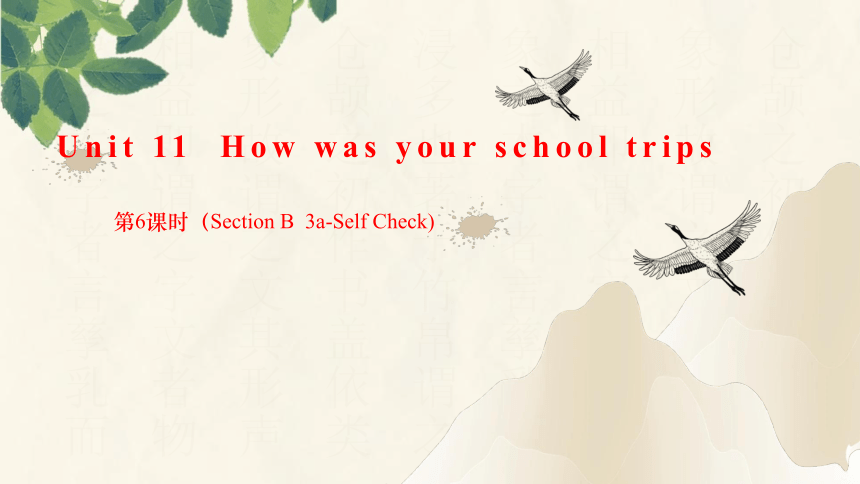 | |
| 格式 | pptx | ||
| 文件大小 | 7.2MB | ||
| 资源类型 | 试卷 | ||
| 版本资源 | 人教新目标(Go for it)版 | ||
| 科目 | 英语 | ||
| 更新时间 | 2024-04-14 11:47:59 | ||
图片预览

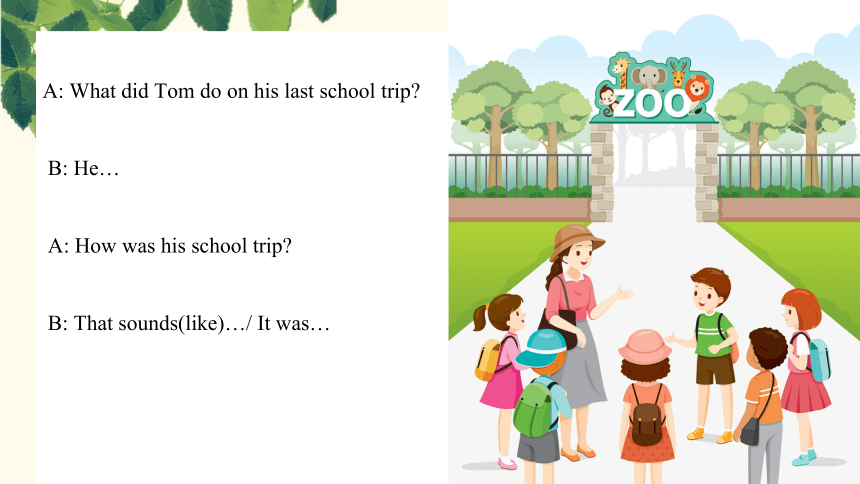
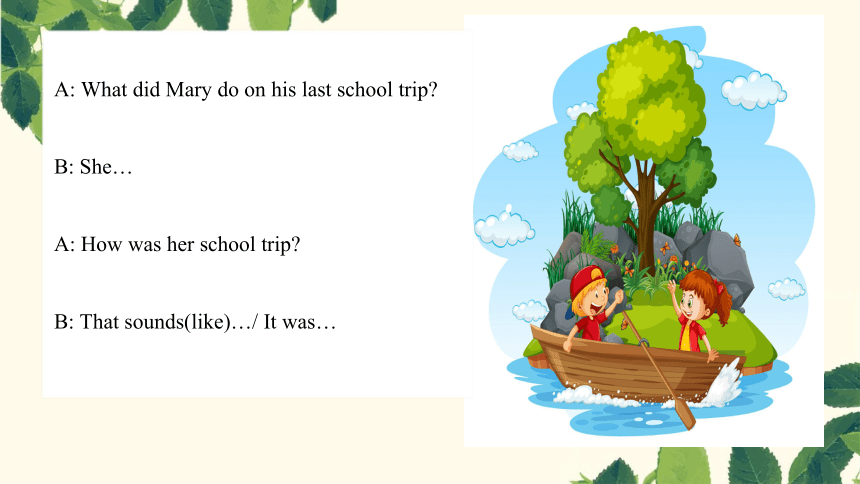
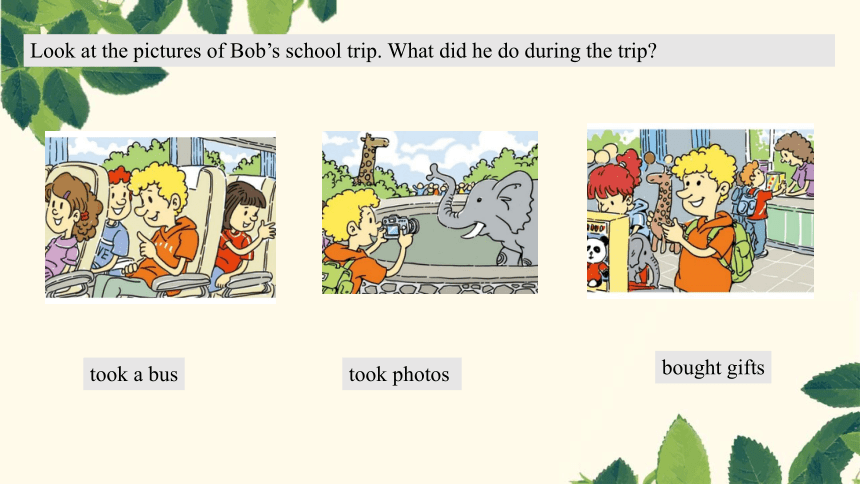
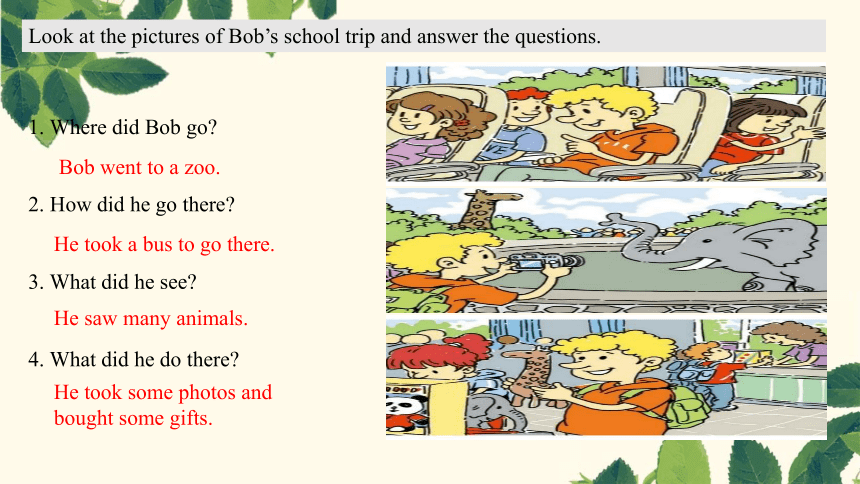
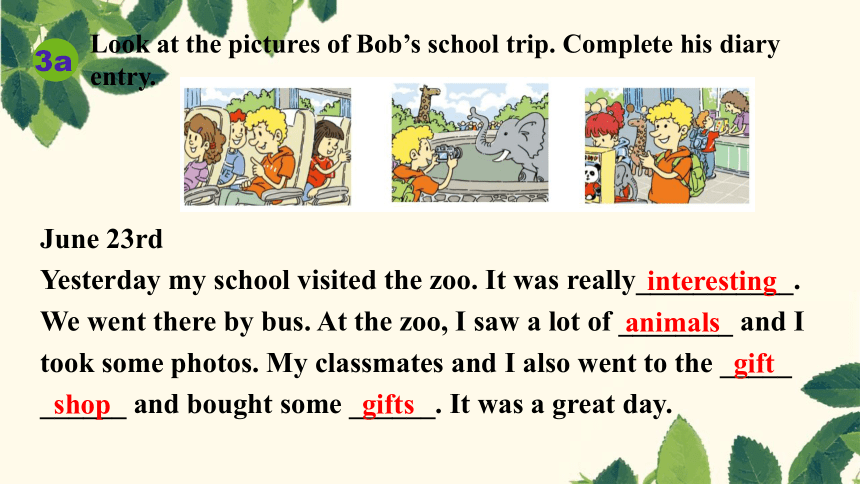
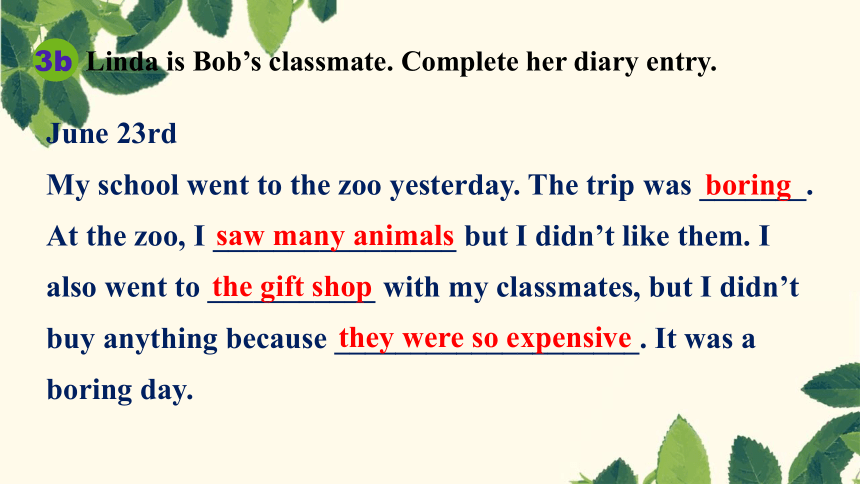
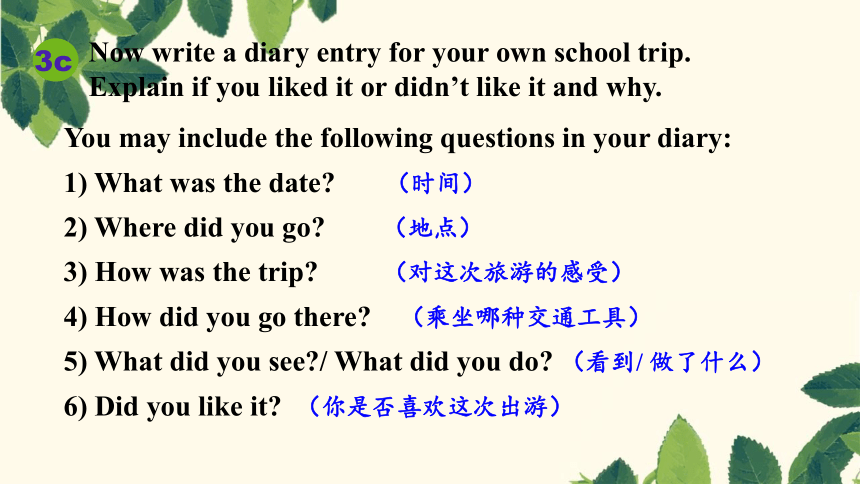
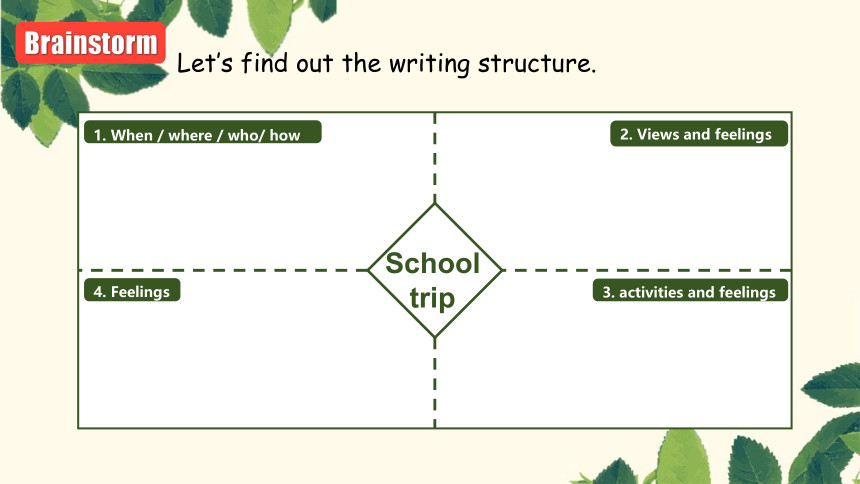
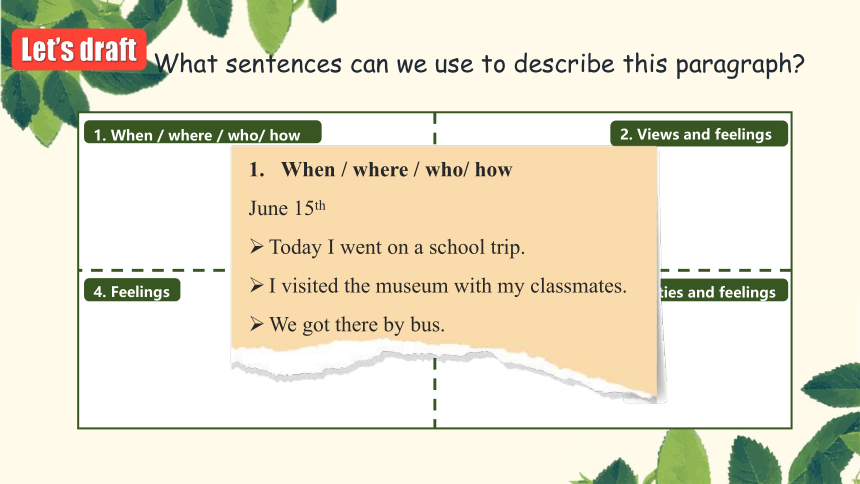
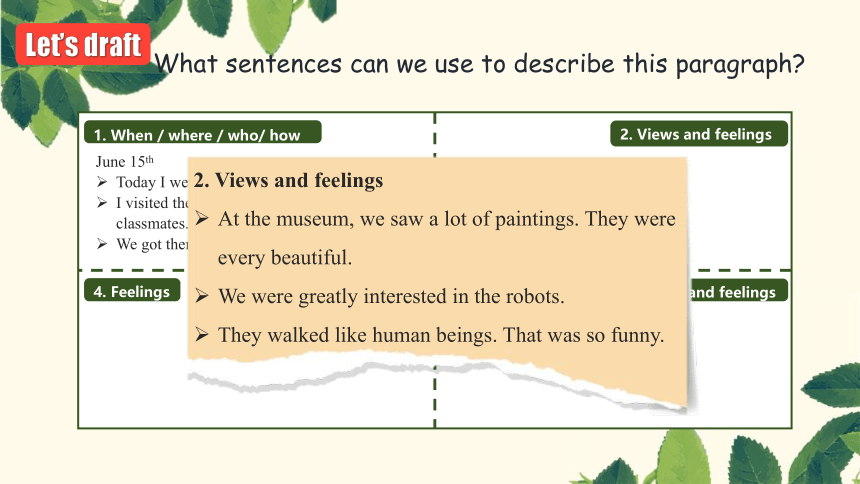
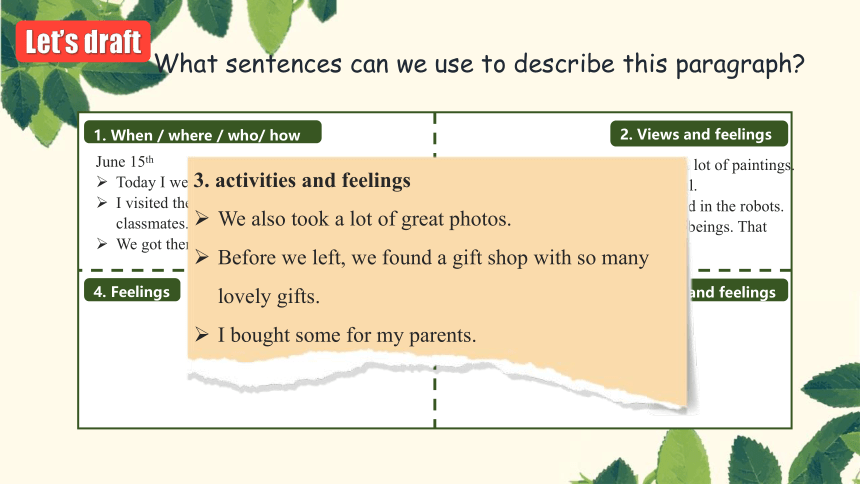
文档简介
(共32张PPT)
仓颉之初作书盖依类象形故谓之文其形声相益即谓之字文者物象之本字者言孳乳而浸多也著于竹帛谓之仓颉之初作书盖依类象形故谓之文其形声相益即谓之字文者物象之本字者言孳乳而
Unit 11 How was your school trips
第6课时(Section B 3a-Self Check)
A: What did Tom do on his last school trip
B: He…
A: How was his school trip
B: That sounds(like)…/ It was…
A: What did Mary do on his last school trip
B: She…
A: How was her school trip
B: That sounds(like)…/ It was…
Look at the pictures of Bob’s school trip. What did he do during the trip
bought gifts
took a bus
took photos
Look at the pictures of Bob’s school trip and answer the questions.
1. Where did Bob go
2. How did he go there
3. What did he see
4. What did he do there
He saw many animals.
Bob went to a zoo.
He took a bus to go there.
He took some photos and bought some gifts.
June 23rd
Yesterday my school visited the zoo. It was really___________. We went there by bus. At the zoo, I saw a lot of ________ and I took some photos. My classmates and I also went to the _____
______ and bought some ______. It was a great day.
3a
Look at the pictures of Bob’s school plete his diary entry.
interesting
gift
animals
gifts
shop
3b
Linda is Bob’s plete her diary entry.
June 23rd
My school went to the zoo yesterday. The trip was _______.
At the zoo, I ________________ but I didn’t like them. I also went to ___________ with my classmates, but I didn’t buy anything because ____________________. It was a boring day.
boring
the gift shop
saw many animals
they were so expensive
Now write a diary entry for your own school trip. Explain if you liked it or didn’t like it and why.
3c
You may include the following questions in your diary:
1) What was the date (时间)
2) Where did you go (地点)
3) How was the trip (对这次旅游的感受)
4) How did you go there (乘坐哪种交通工具)
5) What did you see / What did you do (看到/ 做了什么)
6) Did you like it (你是否喜欢这次出游)
Brainstorm
Let’s find out the writing structure.
School trip
1. When / where / who/ how
2. Views and feelings
3. activities and feelings
4. Feelings
Let’s draft
What sentences can we use to describe this paragraph
School trip
1. When / where / who/ how
2. Views and feelings
3. activities and feelings
4. Feelings
When / where / who/ how
June 15th
Today I went on a school trip.
I visited the museum with my classmates.
We got there by bus.
Let’s draft
What sentences can we use to describe this paragraph
School trip
1. When / where / who/ how
2. Views and feelings
3. activities and feelings
4. Feelings
June 15th
Today I went on a school trip.
I visited the museum with my classmates.
We got there by bus.
2. Views and feelings
At the museum, we saw a lot of paintings. They were every beautiful.
We were greatly interested in the robots.
They walked like human beings. That was so funny.
Let’s draft
What sentences can we use to describe this paragraph
School trip
1. When / where / who/ how
2. Views and feelings
3. activities and feelings
4. Feelings
June 15th
Today I went on a school trip.
I visited the museum with my classmates.
We got there by bus.
At the museum, we saw a lot of paintings. They were every beautiful.
We were greatly interested in the robots.
They walked like human beings. That was so funny.
3. activities and feelings
We also took a lot of great photos.
Before we left, we found a gift shop with so many lovely gifts.
I bought some for my parents.
Let’s draft
What sentences can we use to describe this paragraph
School trip
1. When / where / who/ how
2. Views and feelings
3. activities and feelings
4. Feelings
June 15th
Today I went on a school trip.
I visited the museum with my classmates.
We got there by bus.
At the museum, we saw a lot of paintings. They were every beautiful.
We were greatly interested in the robots.
They walked like human beings. That was so funny.
We also took a lot of great photos.
Before we left, we found a gift shop with so many lovely gifts.
I bought some for my parents.
4. Feelings
All in all, it was an exciting day.
I enjoyed the trip a lot.
Let’s draft
What sentences can we use to describe this paragraph
School trip
1. When / where / who/ how
2. Views and feelings
3. activities and feelings
4. Feelings
June 15th
Today I went on a school trip.
I visited the museum with my classmates.
We got there by bus.
At the museum, we saw a lot of paintings. They were every beautiful.
We were greatly interested in the robots.
They walked like human beings. That was so funny.
We also took a lot of great photos.
Before we left, we found a gift shop with so many lovely gifts.
I bought some for my parents.
All in all, it was an exciting day.
I enjoyed the trip a lot.
Let’s proofread
One possible version.
Dear Helen,
Last weekend, I went to Sichuan with my friends. We got there by travel bus. We had a very interesting trip.
In the morning, We went to the zoo that’s because we wanted to see pandas climbing the trees. They are so cute. And we ate many delicious food. In the afternoon, we took photos. After that, we arrived at a shop because I wanted to buy some gifts for my family. In the evening, we went back home.
We felt tired but really happy. All in all, it was an exciting day.
Yours,
Lucy
Self-check and peer-check.
Let’s proofread
check
Check for mistakes:
spelling
grammar
polish
□你分段了吗?
□你的每一段都有主旨吗?
□你包含介绍的基本信息了吗?
□ 你有拼写错误吗?
□ 你有语法错误吗?
□ 你使用连词and了吗?
Let’s evaluate
Let’s edit
评分原则
本题总分15分,按各档次给分。评分时先根据文章的内容、语言质量初步确定档次,然后以档次的要求来衡量,确定或调整档次,最后给分;
评分时应考虑:内容要点是否完整;时态,语态及人称是否正确;词汇和句式的多样性以及语言的准确性;上下文的连贯性;
如书写较差,影响表达,应视其影响程度,降低一到两个档次;英美两种拼法及词汇用法都可接受;
内容要点可用不同方式表达,应紧扣主题,可适当发挥。
随着“双减”政策的实施,同学们的课余时间增多,如何读过周末成为大家讨论的话题。请你根据下图提示为校刊“花样周末”专栏写一篇短文,介绍你的周末。
注意:1. 须全面反映图文信息,并作适当补充;
2. 70词左右。
A Trip to Chengdu Museum
weather
Transportation
A new friend
Activities
Feeling
hair
...
How
How long
How far
...
.
Today is Saturday. The weather was sunny. I visited Chengdu Museum. The museum is about three kilometers from my home. It took me 15 minutes to get there by bus. At the museum, I met a new friend. Her name is Maria. She has long blond hair and big eyes. She is also very outgoing. We talked a lot about things in the museum and I learned about the history of many old things. I took a lot of photos in the museum. I was very happy today.
Self Check
1. Write more verbs and their past forms in each group.
climb → climbed arrive → arrived study → studied
want → wanted work → worked need → needed clean → cleaned
like → liked
live → lived
use → used
move → moved
worry → worried
carry → carried
hurry → hurried
marry → married
stop → stopped get → got
shop → shopped
plan → planned
regret → regretted
prefer → preferred
keep → kept
sleep → slept
sing → sang
give → gave
2 Complete the conversations with the correct forms
of the verbs in the box.
have do swim go be see feed
1. A:I went to the countryside this summer.
B:Really How _____ the trip
A: It _____ great!
B:What _____ you ____ there
A:I ____ the chickens and ______ in a river.
was
was
did do
fed
swam
2. A: _____ you ______ a nice weekend
B: Yes, I did.
A: _____ you ____ anywhere
B: Yes, I ______ to the mountains. The air
_____ so clean, and I _____ a lot of flowers.
have do swim go be see feed
Did have
Did go
went
was
saw
Language points
1. At the zoo,I saw a lot of animals and I took some photos.
在动物园,我看到了很多动物并且照了很多照片。
1) a lot of=lots of,意为“很多”,既可以修饰不可数名词也可以修饰可数名词的复数形式,可以相应地换为much和many。
2)本句是由两个分句构成的并列句, and是并列连词, 表示并列关系。and还可用来连接单词、短语, 表示并列、顺承。
【拓展】
并列连词but意为“但是;而是;然而”, 表示转折关系, 所连接的成分意思相反或相对。
I also went to the gift shop with my classmates,but I didn't buy anything.
我还和同学们去了礼品店, 但我没买任何东西。
2、everything, something, anything, nothing区别
everything 意为“所有事物; 一切”
something 意为 “某事,某物”,通常用于肯定句,也可用于征求对方意见的疑问句中
anything 意为“任何东西;任何事物”,通常用于否定句或疑问句中
nothing 意为“没有什么”,本身是否定词,相当于not.....anything
3、dark此处为形容词,意为“黑暗的;昏暗的”。其反义词为bright,意为“光明的”。
It's getting dark.天快黑了。
①dark用作形容词,还表示“深色的",反义词为light,意为“(颜色)浅的”。
My daughter likes the dark. 我女儿喜欢深绿色
②dark还可用作名词,意为“黑暗;暗处”。
I could see nothing in the dark.在黑暗中我什么也看不清。
4、not at all的用法
①当别人向你表示感谢时,你可以回答not at all“不用谢,不客气”。
—Thank you very much for helping us.
非常感谢你帮助我们。
— Not at all.
不用谢。
② 别人向你致歉时,你可以回答not at all“没关系”。
—I'm sorry I'm late.
对不起,我迟到了。
5、bring的用法
1)bring作动词用,意为“带来”,其过去式为brought
常构成短语:bring sb. sth. = bring sth. to sb. 意为“给某人带来某物”
bring up 意为“养育”。
2)bring, take, carry与get的用法辨析:
bring表示从别处把某人或物“带来”或“拿来”
take指把某人或物“带走”或“拿走”(到别处)
carry指“搬运”,不具体说明来去的方向,有时含有沉重或麻烦之意
get 指到别处把某物取来, 相当于 go and bring
6、smile
(1)smile作动词用,常构成短语:smile at, 意为“对……微笑”;
(2)smile作名词用,常构成短语:with a smile on one’s face, 意为“某人面带微笑”;
(3)smile和laugh的区别:
smile一般是无声的微笑
laugh一般是有声的笑、大笑,laugh at 是嘲笑。
7、It’s + 形容词 + to do sth. 句型
1)在英语中,如果作主语的动词不定式太长,为了避免头重脚轻,一般用it作形式主语,而将真正的主语置于句尾。
2)It is+形容词+of sb. + to do sth.形容词描述行为者的性格品质如kind, nice, polite等.
It is+形容词+for sb. + to do sth. 形容词描述事物的特征、性质
It’s kind of you to help me. 帮助我,你是善良的
一、根据句意,用括号中所给单词的正确形式填空。
1. Jack always _____ (get) up early in the morning.
2. My brother is _______ (run) outside at the moment.
3. The child ____ (see) his old friend on the way home yesterday.
4. ______ he ______ (go) fishing last weekend
5. They are ________ (arrive) in Canada in two days.
gets
running
saw
Did go
arriving
二、按要求完成下列句子。
1. Dale and his father went fishing yesterday afternoon. (改为一般疑问句)
Dale and his father fishing yesterday afternoon
2. My sister arrived late for school last Monday.(改为否定句)
My sister late for school last Monday.
3. Jill's summer vacation was boring. (对画线部分提问)
Jill's summer vacation
4. Amy and her friends climbed a mountain two days ago. (对画线部分提问)
Amy and her friends do two days ago
Did go
didn't arrive
How was
What did
仓颉之初作书盖依类象形故谓之文其形声相益即谓之字文者物象之本字者言孳乳而浸多也著于竹帛谓之仓颉之初作书盖依类象形故谓之文其形声相益即谓之字文者物象之本字者言孳乳而
谢君一赏
仓颉之初作书盖依类象形故谓之文其形声相益即谓之字文者物象之本字者言孳乳而浸多也著于竹帛谓之仓颉之初作书盖依类象形故谓之文其形声相益即谓之字文者物象之本字者言孳乳而
Unit 11 How was your school trips
第6课时(Section B 3a-Self Check)
A: What did Tom do on his last school trip
B: He…
A: How was his school trip
B: That sounds(like)…/ It was…
A: What did Mary do on his last school trip
B: She…
A: How was her school trip
B: That sounds(like)…/ It was…
Look at the pictures of Bob’s school trip. What did he do during the trip
bought gifts
took a bus
took photos
Look at the pictures of Bob’s school trip and answer the questions.
1. Where did Bob go
2. How did he go there
3. What did he see
4. What did he do there
He saw many animals.
Bob went to a zoo.
He took a bus to go there.
He took some photos and bought some gifts.
June 23rd
Yesterday my school visited the zoo. It was really___________. We went there by bus. At the zoo, I saw a lot of ________ and I took some photos. My classmates and I also went to the _____
______ and bought some ______. It was a great day.
3a
Look at the pictures of Bob’s school plete his diary entry.
interesting
gift
animals
gifts
shop
3b
Linda is Bob’s plete her diary entry.
June 23rd
My school went to the zoo yesterday. The trip was _______.
At the zoo, I ________________ but I didn’t like them. I also went to ___________ with my classmates, but I didn’t buy anything because ____________________. It was a boring day.
boring
the gift shop
saw many animals
they were so expensive
Now write a diary entry for your own school trip. Explain if you liked it or didn’t like it and why.
3c
You may include the following questions in your diary:
1) What was the date (时间)
2) Where did you go (地点)
3) How was the trip (对这次旅游的感受)
4) How did you go there (乘坐哪种交通工具)
5) What did you see / What did you do (看到/ 做了什么)
6) Did you like it (你是否喜欢这次出游)
Brainstorm
Let’s find out the writing structure.
School trip
1. When / where / who/ how
2. Views and feelings
3. activities and feelings
4. Feelings
Let’s draft
What sentences can we use to describe this paragraph
School trip
1. When / where / who/ how
2. Views and feelings
3. activities and feelings
4. Feelings
When / where / who/ how
June 15th
Today I went on a school trip.
I visited the museum with my classmates.
We got there by bus.
Let’s draft
What sentences can we use to describe this paragraph
School trip
1. When / where / who/ how
2. Views and feelings
3. activities and feelings
4. Feelings
June 15th
Today I went on a school trip.
I visited the museum with my classmates.
We got there by bus.
2. Views and feelings
At the museum, we saw a lot of paintings. They were every beautiful.
We were greatly interested in the robots.
They walked like human beings. That was so funny.
Let’s draft
What sentences can we use to describe this paragraph
School trip
1. When / where / who/ how
2. Views and feelings
3. activities and feelings
4. Feelings
June 15th
Today I went on a school trip.
I visited the museum with my classmates.
We got there by bus.
At the museum, we saw a lot of paintings. They were every beautiful.
We were greatly interested in the robots.
They walked like human beings. That was so funny.
3. activities and feelings
We also took a lot of great photos.
Before we left, we found a gift shop with so many lovely gifts.
I bought some for my parents.
Let’s draft
What sentences can we use to describe this paragraph
School trip
1. When / where / who/ how
2. Views and feelings
3. activities and feelings
4. Feelings
June 15th
Today I went on a school trip.
I visited the museum with my classmates.
We got there by bus.
At the museum, we saw a lot of paintings. They were every beautiful.
We were greatly interested in the robots.
They walked like human beings. That was so funny.
We also took a lot of great photos.
Before we left, we found a gift shop with so many lovely gifts.
I bought some for my parents.
4. Feelings
All in all, it was an exciting day.
I enjoyed the trip a lot.
Let’s draft
What sentences can we use to describe this paragraph
School trip
1. When / where / who/ how
2. Views and feelings
3. activities and feelings
4. Feelings
June 15th
Today I went on a school trip.
I visited the museum with my classmates.
We got there by bus.
At the museum, we saw a lot of paintings. They were every beautiful.
We were greatly interested in the robots.
They walked like human beings. That was so funny.
We also took a lot of great photos.
Before we left, we found a gift shop with so many lovely gifts.
I bought some for my parents.
All in all, it was an exciting day.
I enjoyed the trip a lot.
Let’s proofread
One possible version.
Dear Helen,
Last weekend, I went to Sichuan with my friends. We got there by travel bus. We had a very interesting trip.
In the morning, We went to the zoo that’s because we wanted to see pandas climbing the trees. They are so cute. And we ate many delicious food. In the afternoon, we took photos. After that, we arrived at a shop because I wanted to buy some gifts for my family. In the evening, we went back home.
We felt tired but really happy. All in all, it was an exciting day.
Yours,
Lucy
Self-check and peer-check.
Let’s proofread
check
Check for mistakes:
spelling
grammar
polish
□你分段了吗?
□你的每一段都有主旨吗?
□你包含介绍的基本信息了吗?
□ 你有拼写错误吗?
□ 你有语法错误吗?
□ 你使用连词and了吗?
Let’s evaluate
Let’s edit
评分原则
本题总分15分,按各档次给分。评分时先根据文章的内容、语言质量初步确定档次,然后以档次的要求来衡量,确定或调整档次,最后给分;
评分时应考虑:内容要点是否完整;时态,语态及人称是否正确;词汇和句式的多样性以及语言的准确性;上下文的连贯性;
如书写较差,影响表达,应视其影响程度,降低一到两个档次;英美两种拼法及词汇用法都可接受;
内容要点可用不同方式表达,应紧扣主题,可适当发挥。
随着“双减”政策的实施,同学们的课余时间增多,如何读过周末成为大家讨论的话题。请你根据下图提示为校刊“花样周末”专栏写一篇短文,介绍你的周末。
注意:1. 须全面反映图文信息,并作适当补充;
2. 70词左右。
A Trip to Chengdu Museum
weather
Transportation
A new friend
Activities
Feeling
hair
...
How
How long
How far
...
.
Today is Saturday. The weather was sunny. I visited Chengdu Museum. The museum is about three kilometers from my home. It took me 15 minutes to get there by bus. At the museum, I met a new friend. Her name is Maria. She has long blond hair and big eyes. She is also very outgoing. We talked a lot about things in the museum and I learned about the history of many old things. I took a lot of photos in the museum. I was very happy today.
Self Check
1. Write more verbs and their past forms in each group.
climb → climbed arrive → arrived study → studied
want → wanted work → worked need → needed clean → cleaned
like → liked
live → lived
use → used
move → moved
worry → worried
carry → carried
hurry → hurried
marry → married
stop → stopped get → got
shop → shopped
plan → planned
regret → regretted
prefer → preferred
keep → kept
sleep → slept
sing → sang
give → gave
2 Complete the conversations with the correct forms
of the verbs in the box.
have do swim go be see feed
1. A:I went to the countryside this summer.
B:Really How _____ the trip
A: It _____ great!
B:What _____ you ____ there
A:I ____ the chickens and ______ in a river.
was
was
did do
fed
swam
2. A: _____ you ______ a nice weekend
B: Yes, I did.
A: _____ you ____ anywhere
B: Yes, I ______ to the mountains. The air
_____ so clean, and I _____ a lot of flowers.
have do swim go be see feed
Did have
Did go
went
was
saw
Language points
1. At the zoo,I saw a lot of animals and I took some photos.
在动物园,我看到了很多动物并且照了很多照片。
1) a lot of=lots of,意为“很多”,既可以修饰不可数名词也可以修饰可数名词的复数形式,可以相应地换为much和many。
2)本句是由两个分句构成的并列句, and是并列连词, 表示并列关系。and还可用来连接单词、短语, 表示并列、顺承。
【拓展】
并列连词but意为“但是;而是;然而”, 表示转折关系, 所连接的成分意思相反或相对。
I also went to the gift shop with my classmates,but I didn't buy anything.
我还和同学们去了礼品店, 但我没买任何东西。
2、everything, something, anything, nothing区别
everything 意为“所有事物; 一切”
something 意为 “某事,某物”,通常用于肯定句,也可用于征求对方意见的疑问句中
anything 意为“任何东西;任何事物”,通常用于否定句或疑问句中
nothing 意为“没有什么”,本身是否定词,相当于not.....anything
3、dark此处为形容词,意为“黑暗的;昏暗的”。其反义词为bright,意为“光明的”。
It's getting dark.天快黑了。
①dark用作形容词,还表示“深色的",反义词为light,意为“(颜色)浅的”。
My daughter likes the dark. 我女儿喜欢深绿色
②dark还可用作名词,意为“黑暗;暗处”。
I could see nothing in the dark.在黑暗中我什么也看不清。
4、not at all的用法
①当别人向你表示感谢时,你可以回答not at all“不用谢,不客气”。
—Thank you very much for helping us.
非常感谢你帮助我们。
— Not at all.
不用谢。
② 别人向你致歉时,你可以回答not at all“没关系”。
—I'm sorry I'm late.
对不起,我迟到了。
5、bring的用法
1)bring作动词用,意为“带来”,其过去式为brought
常构成短语:bring sb. sth. = bring sth. to sb. 意为“给某人带来某物”
bring up 意为“养育”。
2)bring, take, carry与get的用法辨析:
bring表示从别处把某人或物“带来”或“拿来”
take指把某人或物“带走”或“拿走”(到别处)
carry指“搬运”,不具体说明来去的方向,有时含有沉重或麻烦之意
get 指到别处把某物取来, 相当于 go and bring
6、smile
(1)smile作动词用,常构成短语:smile at, 意为“对……微笑”;
(2)smile作名词用,常构成短语:with a smile on one’s face, 意为“某人面带微笑”;
(3)smile和laugh的区别:
smile一般是无声的微笑
laugh一般是有声的笑、大笑,laugh at 是嘲笑。
7、It’s + 形容词 + to do sth. 句型
1)在英语中,如果作主语的动词不定式太长,为了避免头重脚轻,一般用it作形式主语,而将真正的主语置于句尾。
2)It is+形容词+of sb. + to do sth.形容词描述行为者的性格品质如kind, nice, polite等.
It is+形容词+for sb. + to do sth. 形容词描述事物的特征、性质
It’s kind of you to help me. 帮助我,你是善良的
一、根据句意,用括号中所给单词的正确形式填空。
1. Jack always _____ (get) up early in the morning.
2. My brother is _______ (run) outside at the moment.
3. The child ____ (see) his old friend on the way home yesterday.
4. ______ he ______ (go) fishing last weekend
5. They are ________ (arrive) in Canada in two days.
gets
running
saw
Did go
arriving
二、按要求完成下列句子。
1. Dale and his father went fishing yesterday afternoon. (改为一般疑问句)
Dale and his father fishing yesterday afternoon
2. My sister arrived late for school last Monday.(改为否定句)
My sister late for school last Monday.
3. Jill's summer vacation was boring. (对画线部分提问)
Jill's summer vacation
4. Amy and her friends climbed a mountain two days ago. (对画线部分提问)
Amy and her friends do two days ago
Did go
didn't arrive
How was
What did
仓颉之初作书盖依类象形故谓之文其形声相益即谓之字文者物象之本字者言孳乳而浸多也著于竹帛谓之仓颉之初作书盖依类象形故谓之文其形声相益即谓之字文者物象之本字者言孳乳而
谢君一赏
同课章节目录
- Unit 1 Can you play the guitar?
- Section A
- Section B
- Unit 2 What time do you go to school?
- Section A
- Section B
- Unit 3 How do you get to school?
- Section A
- Section B
- Unit 4 Don't eat in class.
- Section A
- Section B
- Unit 5 Why do you like pandas?
- Section A
- Section B
- Unit 6 I'm watching TV.
- Section A
- Section B
- Review of Units 1-6
- Unit 7 It's raining!
- Section A
- Section B
- Unit 8 Is there a post office near here?
- Section A
- Section B
- Unit 9 What does he look like?
- Section A
- Section B
- Unit 10 I'd like some noodles.
- Section A
- Section B
- Unit 11 How was your school trip?
- Section A
- Section B
- Unit 12 What did you do last weekend?
- Section A
- Section B
